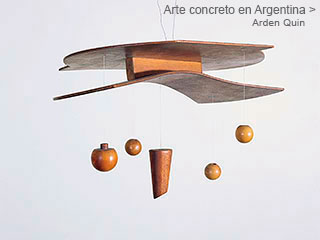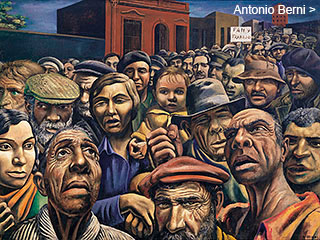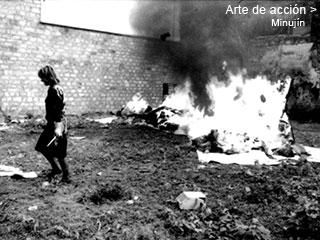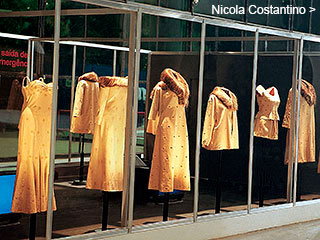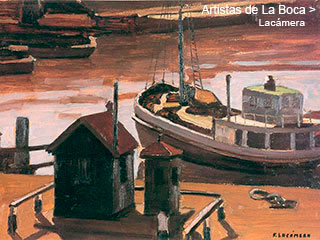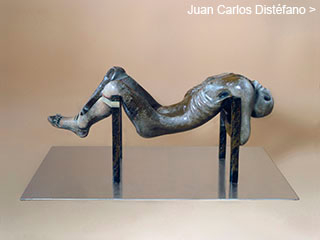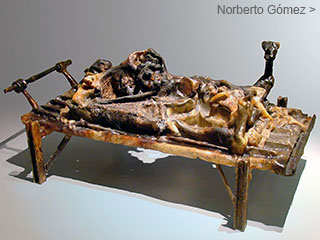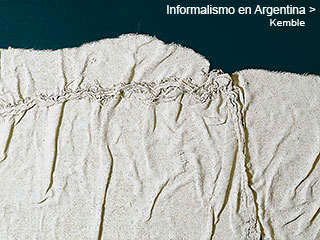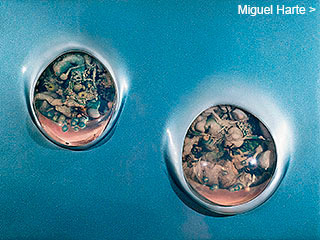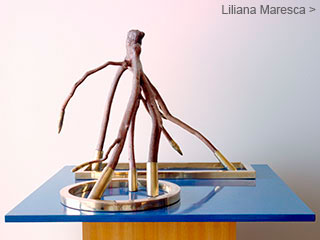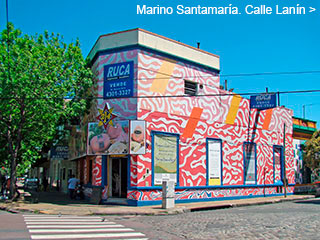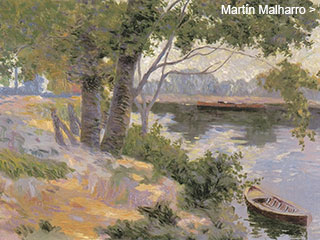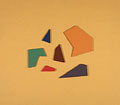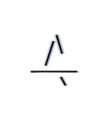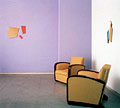Menú
Algunos dossiers
Concrete Art
in Argentina
in Argentina
by
Adriana Lauria
January 2003
January 2003
Abstraction asserted itself in Argentina through the achievements of groups such as Arte Concreto-Invención, Madí and Perceptismo, which developed their activity since the second half of the 1940s. These groups constituted the first organized national avant-garde and made their aesthetics known to the public through exhibitions, magazines, manifestoes, leaflets, lectures, etc.
Perceptismo
Raúl Lozza  experimented in 1946 on independent shapes arranged in a co-planar manner, while he sustained it still had to be considered the spatial context where the work would unfold, that is to say, the visual and environmental features of the wall in which the forms would be placed.
experimented in 1946 on independent shapes arranged in a co-planar manner, while he sustained it still had to be considered the spatial context where the work would unfold, that is to say, the visual and environmental features of the wall in which the forms would be placed.
By 1947 he already had some ideas on how to approach the problem and he exposed them in the heart of the Arte Concreto-Invención Association. The rest of the members found that the trimmed shapes offered restrictions and they decided to go back to the quadrangular supports. This divergence, in addition to personal reasons, caused Lozza to walk out from the Association.
After giving a lecture at the Centro Cultural Ramos Mejía, where he presented an exhibition, Lozza met Abraham Haber, then a student in the College of Philosophy and Letters, who was interested in his ideas and soon began to write about them. It was Haber who proposed the name of Perceptismo for this new stage in the work of Lozza, due to the relevance that perception had in it as a cognitive method, through which the transformation of man would take effect.
Transposing to the world of painting some notions of modern Physics and Mathematics, such as Planck’s theory of quanta, Einstein’s theory of relativity or the equations that define Maxwell’s electromagnetic field, Lozza pursued to elaborate in Art a system comparable to the scientific method, avoiding it to be a merely illustrative testimony, to achieve instead a nature according to the advanced knowledge of the time.
Shortly after he elaborated a precise technique. Problems such as the “open structure” (a project design system ruled by centrifuge strength lines according to which shapes are defined), the “qualimetry of the plane shape” (with which the shape-color relationship is adjusted and controlled) and the notion of “colored field” (as the place in which the painting is set up, ideally the architectonic wall with which it interacts), made up the main constituents of a method the goal of which was the production of true Concrete works. These met the longing Lozza expressed of performing “an art of joyful experiences, of physical, objective beauty, of humanity and progress, able to connect man with the unknown, activating his knowledge and his own creative awareness.” 
Raúl Lozza
Pintura n° 211 (structure), 1947
Pintura n° 211 (structure), 1947
Raúl Lozza
Propuesta de dibujo concreto H, 1947
Propuesta de dibujo concreto H, 1947
Rembrandt V. D. Lozza
Objeto estético, 1946
Objeto estético, 1946
In 1949 opened at the Van Riel gallery Raúl Lozza. Primera exposición de pintura perceptista (Raúl Lozza. First Exhibition of Perceptista Painting). In the way of a manifesto, the catalogue features a text by the artist in which he states:
“Perceptismo is not complemented by the environment, but it drives the environment’s development. It is not an outcome of the environment, but it is determined through the environment’s renewing power. [...] It is not the shelter of painting in a geometric and mathematic idealism, but the integrity [sic] to its historical reality and to the unequivocal, unmistakable nature of its social role as a revolutionary fact and as a dialectic process of creation material elements. [...] Thus, Perceptismo reveals itself as the superior and most advanced stage in painting. It opens a new age in Art, and it defers from the rest of Abstract and Concrete schools in the essential fact that it has achieved for the first time ever the reality of the color-plane, a new concept of structure intimately related to the practical processing of the creation’s visible means, and the prevailing over the contradictions between form and contents, raison d’être of the representative art and nightmare of the abstract art.”
In the same printing Abraham Haber asserts:
“(The perceptista painting) is as it is seen and is seen as it is [...] (Perceptismo) is not an art of museum, place to which man goes, according to a predetermined timetable, to look for his ration of aesthetic feelings, but an “ambient” art that must go together with man in his daily center; at home, in the public buildings, in the means of transport, in the offices, in the workshops and streets, for it must reach man in the expression of his actuality and not in the exhaust pipe a museum room is.
Between 1950 and 1953 Lozza wrote, designed and published the seven issues of the Perceptismo magazine, in which his brother Rembrandt and Haber collaborated. This publication showed part of the copious theoretical production that always went along with his artistic labor. One of his researches’ essential subjects was perhaps the color. The first issue of the magazine included an article entitled “The Color in Art. Resumé and excerpts from a book in printing”, which as a book remains unedited. He insisted there on the concept of unity between form and color. The interacting of these determined the structural harmony of a painting, organization in which every shape is corresponded by an established intensity of color.
Raúl Lozza. A setting of his works in the retrospective exhibition held at the Museo de Arte Moderno,
Buenos Aires, 1997
Buenos Aires, 1997
Some of the key concepts for an ideal materialization of Lozza’s works were published in 1952 in the No. 4 of Perceptismo:
“[…] The previous considerations where the plastic event should germinate, have exceeded through Perceptismo the narrow limits of the wall as a background or of the classic rectangular canvas […] When talking about pictorial structure, our first reflections will be:
1) The whole dimension of the architectonic wall;
2) The average distance between this one and the spectator;
3) The pictorial vision field or the simultaneous perception angle;
4) The wall’s REAL color and the SEEMING chromatic intensity according to the light and the distance space, and
5) The structural field or the space bounded by the reference points.”
To avoid the hazards derived from incidental surfaces, Lozza installed his works on enameled plates, which he considered to be wall fragments and not enclosure frames. Arranged at a certain distance, as if they were floating over these “wall cuttings”, the forms kept a color rapport with them by means of “qualimetric” reckonings, based on a chart of more than 4,200 classified hues.
His way of conceiving painting persists today, and, with time, the system formerly ruled by mathematical formulas,  mingled to such extent with the methodology of work that it finally looked like an intuitive procedure. His influence on later abstract artists is a deep one. In 1993, Jorge López Anaya wrote about it:
mingled to such extent with the methodology of work that it finally looked like an intuitive procedure. His influence on later abstract artists is a deep one. In 1993, Jorge López Anaya wrote about it:
“Today´s debates on painting have caused Lozza to attain a remarkable topicality […] The reason is simple. His work, as seen from an ontology of the present, of the ‘we’, encloses certain keys to ‘painting’ when the practice of it, in nearly all cases is an abolition of the pictorial.
On the other hand […] he deconstructed the painting. He rejected the idea about the myth of the unique, irreplaceable piece; he modified the position of the ‘author’ in front of it. His work, it is an essential data, can be replicated according to a precise projectual annotation and a complex codification of elements. It seems […] to refer to the melancholic extinction of the soul predicted by Benjamin.”


